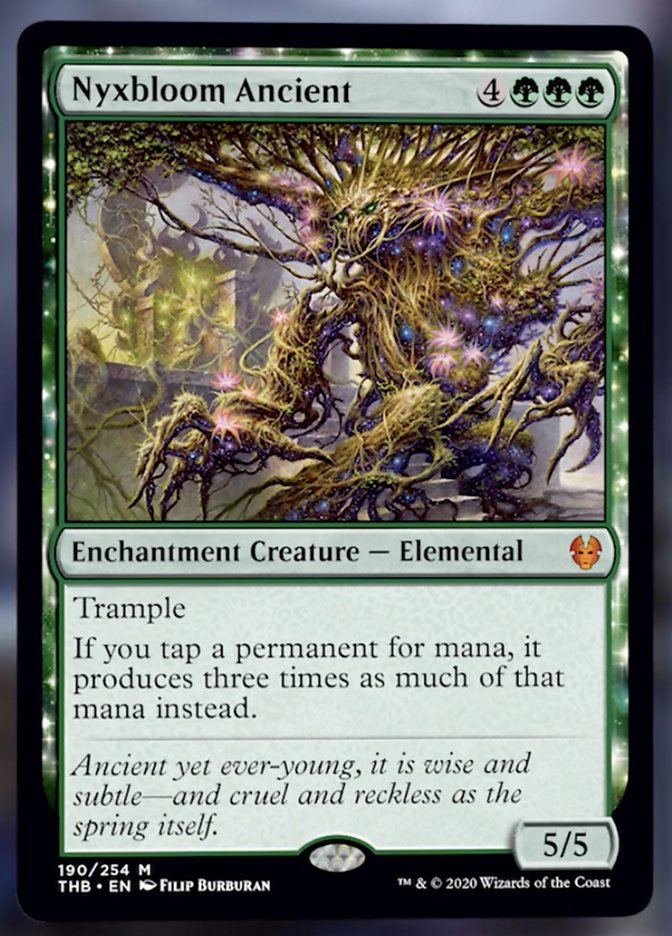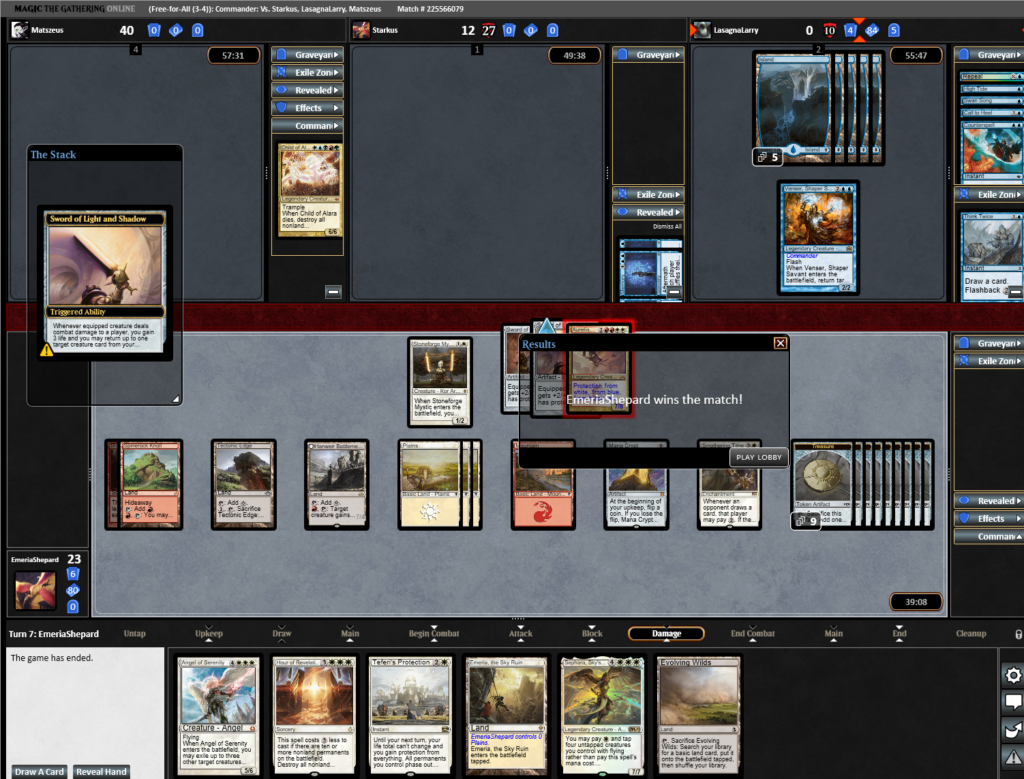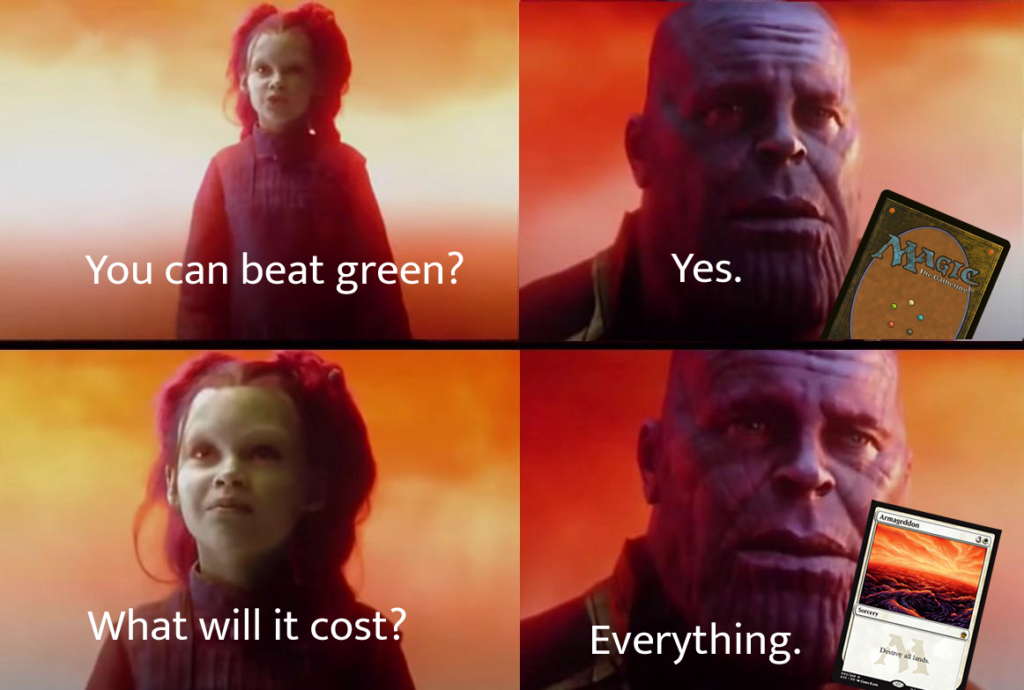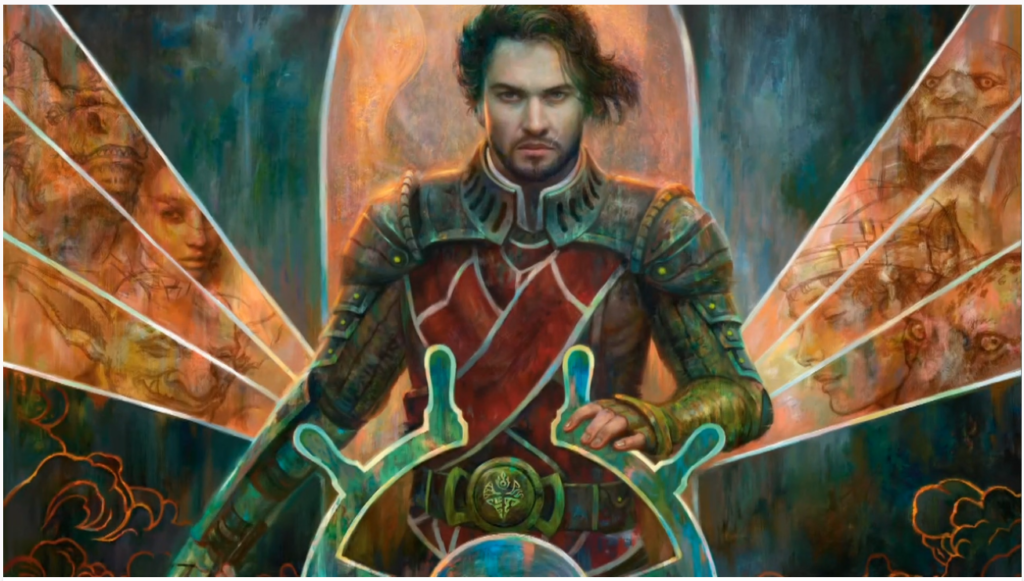This week on Legion’s Landing, Kristen considers the eternal quandary – whether to play Mass Land Destruction in EDH. Can it ever be done right, while not breaking the Social Contract?
I’m glad I got your attention with that title. With all of the absurd Magic cards revealed in Theros: Beyond Death and the exciting brewing going on around them, I felt like it was necessary to ensure you stopped by. It’s been a pretty good year to be a Green player, and things kind of hit fever pitch for me when Nyxbloom Ancient was revealed.

We absolutely didn’t need this card. There are already a deluge of good mana-doubler effects in Green, like Zendikar Resurgent, Regal Behemoth, and Nissa Who Shakes the World, with other ways to achieve similar effects by dipping into artifacts and secondary colors. It’s been printed, though, and you can fully expect to see it across the table from you – imminently.
Wise & Subtle Indeed
Nyxbloom Ancient probably wouldn’t have produced such a visceral reaction had we also not just seen Dryad of the Ilysian Grove a day or so before. This card is Prismatic Omen meets Courser of Kruphix. Sure, you don’t get to play the top card of your library, but being able to ensure every land in play is a Mountain for Valakut, the Molten Pinnacle? Pretty damned good. It’s also abusable with cards like Cabal Coffers, but I’m not going to go into that in too much detail. The important thing to me is that the Dryad has four toughness. That’s really quite difficult for Red decks in particular to remove, and it blocks a lot of early game creatures like a champ. In my opinion, this card could have had three toughness; nay, two toughness, and still seen widespread play.
Although power creep is very real, and something that is as inevitable as it is frustrating, it doesn’t mean we can’t be critical of the way it plays out. As I mentioned above, Dryad of the Ilysian Grove having four toughness is just too high. It might be appropriate for current Standard, but when it comes to Commander? Very hard to interact with. What’s more, when these effects are printed, and we see them after cards like The Great Henge, Gilded Goose, Questing Beast and Return of the Wildspeaker? Well, it’s hard to feel anything but disbelief at the sheer power given to Commander’s best color, set after set.
The Issue with Green
Currently, there are very few reasons to not play Green in Commander if you want to have a consistent play experience. Flavor and fun aside, the other colors lag far behind Green in their ability to consistently pull off a game plan that doesn’t involve cheap combos. By the time a lot of colors get set up, Green has already ramped into oblivion, and, thanks to its many ways to draw cards – made more powerful when combined with Black, or Blue – the Green player is almost always ahead on board. True control decks with a combo finish can go over the top of this, but any other ‘fair’ deck – basically anything in the Mardu sphere – can’t compete.
Factoring in control elements into these fairer decks means it just takes you longer to get set up too, and so the balancing act of keeping the table in check while trying to win is a hard act to follow through with. Personally, I find that fun, as the resource juggling is akin to playing Limited; for others, though, it can be a nightmare, especially if the decks in their playgroup are unbalanced. It’s very hard to build a Simic or Sultai deck that isn’t accidentally absurd, and this can be seen evidently in the newest episode of Game Knights. Josh is a master deckbuilder, and giving him Uro, Titan of Nature’s Wrath was never going to end well. I won’t spoil the ending, but the main thing to takeaway is that the sheer power of ramping and drawing so many cards, and being able to recast cards like Cyclonic Rift, is an issue at more casual to medium tables.
Commander has gotten quicker over the years, and though I’ve only been playing around four years or so, the format feels completely different in the past year or so than it did for the past three. Games are over quicker, decks are more consistent, and the social contract is more relevant than ever. Whether this is wholly due to power creep is debatable. Some of it is no doubt due to homogenization and tools like EDHRec, some to the expansive and varied content created by the excellent community, and some to the natural evolution of playgroups and card pools over time. Either way, it does feel faster, though, and a large part of that is the power creep.

I’ve recently dived into playing some EDH on Magic: Online, and the experience there is that games are over a whole turn or two faster than they would be in your LGS. I picked up this win with an Aurelia deck I’d say is in the 7-8 range, but the only reason I did? The fact I hit Mana Crypt and got to play a Turn 2 Smothering Tithe. I was playing against a Venser Storm, a Yuriko taking turns deck, and a Child of Alara deck I didn’t see much of. I think I was probably one of the weaker decks at the table, for what it’s worth, and I got through by the skin of my teeth, drawing into cards like Teferi’s Protection and Rebuff the Wicked on important turns.
Mana wins games, and this is no truer than in Commander. The one who spends the most Mana the most efficiently wins the majority of the time. In my Boros Primer, I make a point of recommending cards like Burnished Hart and Sword of the Animist as crucial to the strategy, as lands are more ‘stable’ investments than artifact based mana.
Fast mana is constantly in debate within the community, and I can understand the reservations around it. For every argument that it lets color combinations like Boros catch up with Green by playing cards like Mana Vault, Sol Ring, Smothering Tithe and Mana Crypt, there’s a fair argument that Green decks also have access to these cards, and that it means Boros is no better off. I’m not sure I agree, and partly that’s due to the social contract. Let’s be honest – it’s more acceptable to allow ‘fairer’ decks tools like Sol Ring than it is, say, Tatyova, Benthic Druid. That said, Green isn’t the only offender, with stronger multicolor decks able to take advantage of all of these tools at higher power levels too.
Ultimately, the discrepancy in power level occurs most often in that dreaded ‘average’ range of decks: 7s. I think by and large, banning fast mana would do more to hurt ‘fairer’ decks in this range than it would to stymie unfair ones, which I think can be said about most cards you can ‘break’ in the format, but that’s by the by.
When It’s Time to Embrace Land Destruction
It’s clear that from Wizards’ current understanding and application of the color pie that ‘feels bad’ effects are something they are hesitant to print. Taxing effects rarely see print, and when they do, they’re either overcosted for Standard (Smothering Tithe), too little too late (Suncleanser, Eidolon of Obstruction), not relevant to the format (Damping Sphere), or just not that impactful (Tithe Taker). The most relevant thing here is that we are most likely to see answers and tools printed in Standard legal sets, as they make up most of the new cards printed in any given year. Between that and the relatively lower power level of newer preconstructed Commander decks, we’re unlikely to see the answers we so desperately seek on the horizon.
What if that’s because we’re looking in the wrong place?
Let’s imagine for a second that cards like Nyxbloom Ancient can be, and are printed, because there are already enough answers to it in Commander. First up, it’s an enchantment, so it can be interacted with with twice the amount of removal spells. But what if the issue is compounded by the plethora of other cards that have led to a Green future? It’s very difficult to stop a player who is both ahead on mana but also ahead on draw. There is one way, though.

Armageddon
Three simple words are enough to strike fear into the hearts of all EDH players: Destroy all lands. It’s one of the aspects of the Masters 25 series that was done right, actually – reducing classic cards to simple clean designs (except for Murder, weirdly). Masters sets aside, land destruction is the age old answer to ramp. It’s as old as the game itself, and until the introduction of multiplayer formats, wasn’t really given extended analysis.
In a multiplayer format, though, cards like this can really screw people over. It’s not the fault of Armageddon, per say, but more the people running cards like it. There are few who have the wisdom to cast a card like Armageddon properly, and this means that it’s been all but ‘banned’ from most playgroups due to those who would abuse such power. I’ll be clear from the outset – mass land destruction is not conducive to finishing games of magic in a timely fashion, and will upset most people, unless you build around it properly.
I’m not here to argue that you should all put Jokulhaups into all of your decks, and I think in general, mass land destruction (or MLD) is probably something best kept aside for appropriate occasions. What I will say is that if used responsibly, it can actually put a halt to unreasonable ramp.
Cyclonic Rift, a card I mentioned earlier, can provide some similar context for how MLD can be used to provide a suboptimal play experience. In my article on recursion, I go into detail about how the problem isn’t the Rift, but the timing of it, and the potential to recur it. If all a player does is play a Rift and move no closer to winning the game, it can arbitrarily extend the time of the match, and if this is abused too much, can turn people off. Much like MLD, timing it wrong can make the gameplay experience negative. So, how do you play it right?
Gerrard, Weatherlight Hero: or How I Learned to Stop Worrying, and Love the Bomb

The secret to playing cards like Ravages of War is to set yourself up to either not be affected by them, or to not need them to close out the game after they’re gone.
Achieving the former is easy enough – playing cards like Teferi’s Protection, Boros Charm, or Avacyn, Angel of Hope can mean your lands stick while everyone else’s hit the bin. Be sure to back this up with interaction, though – whilst it’s in nobodies interest to counter your protection, as it’ll set things back to the stone age, they inevitably will try. Keep Red Elemental Blast or Rebuff the Wicked handy. Gerrard, Weatherlight Hero is a great General for this strategy, as your board control options will largely not affect you – when you blow up everyone’s creatures and artifacts, you’ll get yours back easily enough, and repeating this turn after turn with Oblivion Stone will soon tire resources.
An alternative, and slightly less harrowing strategy to this is to drop a Winter Orb when you’re set up to take over the game. If you have something like a Sword of Feast & Famine, Neheb, the Eternal or Smothering Tithe in play, you should be able to ride above the line and not really care. You can even use Goblin Welder or Goblin Engineer to keep it cycling in and out to allow you to untap. The secret is still to play this at the optimal moment – there’s no use grinding the game to a halt for no good reason.
In Closing
Gerrard was printed just this year, and if considered in the wider context, means that at least the pieces are there to answer mass land ramp, even if the motivation might not be. Consider, while you’re playing, that if people have no issue blowing up mana dorks, artifact ramp and enchantment ramp, why they should be overtly offended at the loss of their lands. I cast a Volcanic Offering recently, and targeted a land of the player who was very far ahead on board. They lost only a dual color source, with enough basics for it not to be an issue, and got quite upset – even when I deliberately didn’t hose them by making another player also target them. In the grand scheme of things, losing one or two lands is normal. It’s our attitudes that aren’t.
While mass land destruction can be an issue, I’d argue its more about when and where you pull it out, and how you use it. In order to stop worrying about the Sultai boogieman colors of the format, we might need to re-address what makes a deck ‘balanced’ for play at certain power levels, and one of those things might just be their efficacy with land-based ramp. Depending on your playgroup, it might be easier to play counter to this strategy than try to catch up.

